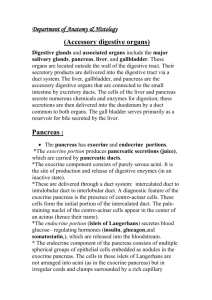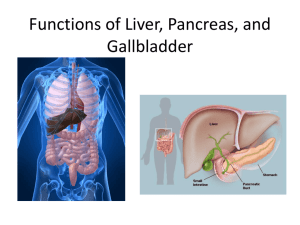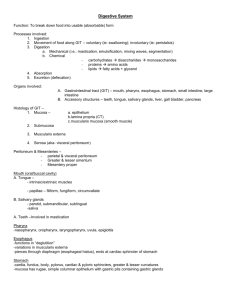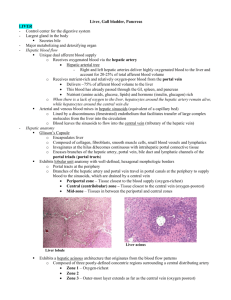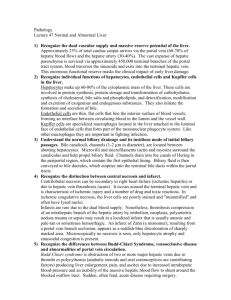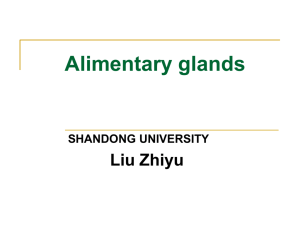CT of the Hepatobiliary System and Pancreas
advertisement
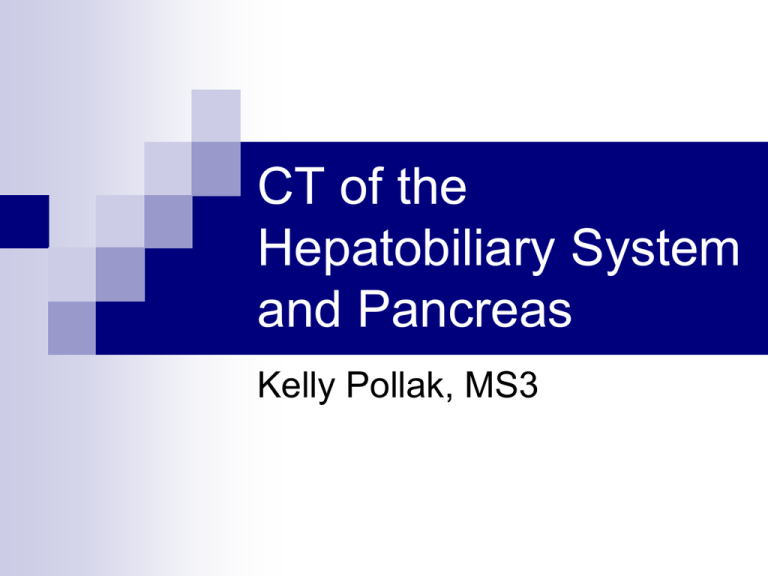
CT of the Hepatobiliary System and Pancreas Kelly Pollak, MS3 Module Outline Part I: Liver Parenchyma Part II: Biliary Tract Part III: Gallbladder Part IV: Pancreas Part I: Liver Parenchyma CT of the Liver Normal Anatomy (as seen on un-enhanced CT): Hepatic parenchyma high density (liver > spleen > muscle) Homogenous appearance of parenchyma Hepatic veins and portal veins branch through parenchyma as lower density structures Hepatic Anatomy – Segments The liver is composed of right and left lobes (separated anatomically by a vertical plane through the IVC, gallbladder fossa, and middle hepatic vein), and a total of 8 segments, which are divided by main hepatic veins and portal veins (inferiorly) Each segment has its own vascular supply and biliary drainage The segments are numbered clockwise when the liver is viewed ventrally It is useful to learn the individual segment locations on CT in order to localize masses Hepatic Segments as seen on CT Superior liver: Left, middle, and right hepatic veins (arrows) can be used to demark segments II, IV, VII, and VIII, and the IVC can be used to locate I (which lies next to it) : Inferior liver: Fissure for falciform ligament appears (block arrow) and the left, middle, and right hepatic veins (black arrows) now can be used to demark segments III, IV, V, VI: Role of intravenous contrast in liver CT Increases the density of normal liver parenchyma Emphasizes difference between parenchyma and poorly enhancing lesions Scans at different time intervals after contrast administration allow visualization of different phases of opacification, enabling distinction of lesions such as hemangiomas and neoplasms IV Contrast Distribution Over Time Three phases of hepatic enhancement post-contrast injection: Vascular: Rapid rise in aortic enhancement and gradual hepatic enhancement Redistribution: Contrast diffuses from central blood compartment to extravascular liver compartment (increase in hepatic enhancement and decrease in aortic) Equilibrium: Aortic and hepatic enhancement gradually decline as contrast diffuses back into central vascular compartment and to muscle and fat compartments Normal liver, unenhanced CT Note the areas of hypodensity (arrows), which are normal hepatic and portal veins coursing through the liver. Photo, Armstrong et al, 2004 Normal liver CT, enhanced Note the increased density of the hepatic and portal veins. Also note the adjacent stomach, which is filled with contrast. Photo, Armstrong et al. 2004 Systematic Approach to Examining Liver Parenchyma Observe for: Overall shape Should have smooth edges cirrhosis Homogeneity of parenchyma Parenchyma should be homogenous. This helps in determining: Liver metastases Primary tumors Abscesses Cysts Trauma Shape Normal liver edges should be smooth: In Cirrhosis, liver edges have a nodular contour: Photo Lee et al, 1998 L=liver, C=caudate lobe Homogeneity: Primary Benign Liver Masses Contrast enhancement helps determine presence of hemangiomas: In early vascular phase, hemangiomas are lower density than surrounding parenchyma During later phases, hemangiomas appear higher density than surrounding parenchyma CT Detection of Hemangioma Early arterial phase Photos, Armstrong et al, 2004 Later (redistribution) phase Homogeneity – Hepatic Neoplasms Contrast enhancement also helps identify hepatic neoplasms: Neoplasms, both metastases and primary neoplasms, can be hyper- or hypovascular. Hypervascular enhance brightly during early arterial phase, whereas hypovascular are hypodense in the early arterial phase (but enhance during the redistribution phase). Homogeneity – Hepatic Neoplasms Knowing which lesions are hypervascular and which are hypovascular can help identify the type of neoplasm, but the key thing is that they are of a different density than the surrounding liver parenchyma. Hypervascular examples: carcinoid tumor mets, hepatocellular carcinoma Hypovascular examples: colon cancer mets, cholangiocarcinoma Most mets, as opposed to primary tumors, are rounded and well demarcated from surrounding parenchyma on enhanced scans. Appearance of various liver neoplasms during early arterial phase Hypovascular metastasis due to colon cancer Carcinoid tumor metastasis is hypervascular Hypovascular primary cholangiocarcinoma Primary hepatocellular carcinoma is hypervascular (hypodense area is necrosis) Homogeneity – Cysts and Abscesses Contrast also helps identify cysts and abscesses, which contain collections of fluid Cysts: Have well-defined margins and are low density (attenuation similar to water), unenhancing lesions Note: cysts below ~ 1cm in size cannot be reliably distinguished from neoplasms Abscesses: appear similar to cysts, but usually their walls are thicker (due to surrounding edema) and more irregular May not be able to distinguish from a necrotic tumor Hepatic Cyst vs. Abscess Photo, Novelline et al, 2004 Photo Lee et al, 1998 Left, hepatic cyst; right, hepatic abscess. Note the thickened wall of the abscess. Homogeneity – Liver Trauma Trauma can cause hepatic parenchymal lacerations, subcapsular and intrahepatic hematomas All are low-density areas relative to contrastenhanced parenchyma Leakage of contrast = active bleeding Hepatic Laceration Photo, www.e-radiography.net Quiz time Identify and localize the following liver abnormalities on CT What is the abnormality, and what segment is it located in? Answer There is hepatocellular carcinoma in the second segment of the liver. Notice how it enhances here during an early arterial phase scan (hypervascular) and is less well defined than metastases would appear. What is the abnormality? Answer This represents cirrhosis of the liver. Note the nodular appearance of the liver, instead of the usual smooth edges characteristic of a normal, healthy liver. What is the abnormality, and in what segment is it located? Image, www.learningradiology.com Answer There is a laceration from a traumatic injury to the liver, located in segment VII. Part II: Biliary Tract CT Normal Anatomy Bile (green tract in image) flows thru biliary tree from periphery of liver to duodenum Biliary tree: intrahepatic ducts, common hepatic duct (CHD), and common bile duct (CBD) Intrahepatic ducts course from periphery centrally to hepatic hilum Join to form centrally located main left and right hepatic ducts Portal triad: intrahepatic ducts are located adjacent to portal veins and hepatic arteries Left and right hepatic ducts join to form common hepatic duct near liver margin Porta Hepatis – CHD runs with portal vein and hepatic artery CHD joins cystic duct to form CBD inferior to the liver Appearance on CT Superior slices: With contrast, intrahepatic ducts appear as hypodense areas in the periphery of the parenchyma (look very closely to see); they appear near portal veins and hepatic arteries, which enhance. More inferior slices: As move inferiorly, right and left hepatic ducts appear centrally (hypodensities, arrows), adjacent to the right and left portal veins (brightly enhancing, block arrows). Appearance on CT, cont’d. Further inferiorly: The left and right main hepatic ducts fuse to form the common hepatic duct, and the left and right portal veins fuse to form the portal vein. Common hepatic duct forming Portal vein forming Even more inferior: Common hepatic duct (and porta hepatis) appears. CHD Hepatic artery Portal vein Appearance on CT, cont’d. Most inferior: Gallbladder appears, left lobe of liver starts to disappear Click through the following slides to familiarize yourself with the progression of the biliary system superior-toinferior within the liver Systematic Approach to Examining Biliary Tract on CT Things to look at: Bile duct size Peripheral ducts: mean diameter=1.8mm Central ducts: mean diameter=2mm Common hepatic duct: mean diameter=2.8mm Bile duct wall Wall enhances to varying degrees with IV contrast (insensitive indicator of pathology) Thickness important; normal 1-1.5mm Density Normal is near water density Abnormalities – Biliary Dilatation Dilated biliary ducts are a feature of biliary obstruction, common causes of which include: Impacted stone in CBD Carcinoma in head of pancreas Carcinoma in ampulla of Vater Note the greatly enlarged intrahepatic bile ducts. As expected, they are hypodense compared to the liver parenchyma. Photo Armstrong et al, 2004 Part III Gallbladder Gallbladder Anatomy Gallbladder is a storage organ It is located within the gallbladder fossa of the liver, which separates the right and left lobes of the liver Its wall is normally thin, and it is usually filled with bile Gallbladder Appearance on CT Sits in fossa between right and left lobes of liver Density: fluid density, free of particulate debris Usually distended with bile Systematic Approach to Observing Gallbladder on CT Observe for three things: size, density, and surroundings: Size: Overall size: Diameter 2-5cm Wall size: 3mm thickness Density: Homogenous, fluid density Surroundings: No surrounding edema should be present Abnormalities – Acute Cholecystitis Size: distended gallbladder, possibly thickened wall, subserosal edema. CHD or CBD may be dilated if they are occluded. Density: gallstones may be visible (usually hyperintense spots); high density bile Surroundings: pericholecystic stranding and fluid (indicating inflammation) Notice the thickened gallbladder wall (arrowheads) and dilated CHD. Photo Lee et al, 1998 Abnormalities – Chronic Cholecystitis Size: Small, irregularly shaped overall Wall: dystrophic calcification (aka, Porcelain Gallbladder) CHD or CBD may be dilated if they are occluded Density: Bile w/particulate matter and high concentration of calcium cmpds appears radio-opaque (aka, Milk of Calcium Bile) Notice the rim of enhancement around the gallbladder, indicating calcification. Photo Novelline RA, 2004 Abnormalities – Gallbladder Carcinoma Major manifestations: Focal/diffuse wall thickening (hard to distinguish from chronic cholecystitis) Discrete intraluminal mass Mass replacing the gallbladder (most common) Shape: well-differentiated, papillary Density: hypointense Notice here the distinct mass within the gallbladder wall. Shape: irregular density: heterogeneous enhancement 2° to tumor necrosis) All may demonstrate dilated bile ducts 2° to obstruction and/or tumor extension to adjacent structures Here the neoplasm appears to be replacing the normal gallbladder (the gallbladder wall also appears thickened). Photos Lee et al, 1998 Part IV Pancreas Pancreas Anatomy Pancreas runs obliquely Retroperitoneal Tail: next to spleen Body: Portal vein Ant to left kidney Ant to sup mesenteric a. Head: Med to 2nd part of duodenum Spleen Pancreas Sup mesenteric vein Sup mesenteric artery Duodenum Pancreas on CT Need several slices to identify all parts of pancreas (due to its oblique orientation) Important to know and make use of surrounding anatomy to locate the pancreas Locating the Tail of the Pancreas The tail lies next to the spleen and ventral to the splenic vein (SV). It is the first part to come into view when advancing through slices superior-to-inferior. Locating the Body of the Pancreas Pancreatic duct The body next comes into view. One can recognize it by its tongue-like shape, and by the hypodense pancreatic duct that runs horizontally through it. Locating the Head of the Pancreas on CT The head lies next to the second part of the duodenum and actually wraps around and lies dorsal to the SMV and SMA: CBD=common bile duct; SMV=superior mesenteric vein; SMA=superior mesenteric artery; D=duodenum; P=pancreas head Use the following video of successive abdominal CT crosssectional slices to familiarize yourself with locating the various parts of the pancreas Left click on the image to play Coronal views of the body illustrating the various parts of the pancreas duodenum spleen tail Can you also see the lesions in the liver? These are hypovascular metastases (this is the same patient from the prior movie). head Systematic Approach to Viewing the Pancreas Things to observe: Size and shape: Tongue-shaped,12-15cm long Diameters: Head: max 3cm Body: max 2.5cm Tail: max 2.0cm Duct: 3-4mm, tapering at tail Density: similar to liver parenchyma Margins: normally appear fluffy Abnormalities – Acute Pancreatitis Typical Presentation: Size/shape: swollen, diffuse enlargement Density: may not enhance w/contrast (signals necrosis) Margins: ill-defined Surroundings: inflammation Photo Lee et al, 1998 inflammation The pancreas is diffusely enlarged and there is inflammation in the surrounding area, notably around the kidneys Abnormalities - Acute Pancreatitis Pseudocysts Presentation: Size: enlarged to varying degrees (cyst can be up to several cm in diameter) Shape: cyst is usually rounded and well-circumscribed Density: cyst is hypodense, thick walled area within pancreas Surroundings: peripancreatic fluid collections/inflammation may be present Note the large pseudocyst in the head of the pancreas. Abnormalities - Chronic Pancreatitis Size and shape: Pancreas: may enlarge generally or focally, or may appear atrophied Duct: may be enlarged and irregular Density: areas of fibrosis and calcification appear hyperintense w/contrast Surroundings: surrounding fluid collections may not be present Chronic pancreatitis, demonstrating numerous areas of calcification Abnormalities – Pancreatic Carcinoma Most neoplasms are adenocarcinomas occurring in the head (2/3) Size and shape: tumor size can be variable; focal mass deforms the outline of the gland Pancreatic duct may be dilated 2° to obstruction by tumor Density: tumor of lower density than pancreatic tissue on enhanced CT Surroundings: tumor spread to lymph nodes, liver, surrounding vessels common A tumor in the body of the pancreas has greatly deformed the shape of the pancreas. Quiz Time Can you find the pancreas? What part is located here? Answer The pancreatic body and tail are seen on this slice. Notice the tail lying next to the spleen. Also note the pancreatic duct running through the body. Pancreatic duct tail spleen Can you tell what the abnormality is? Answer This is acute pancreatitis. Note the diffusely enlarged pancreas and considerable inflammation surrounding it (especially apparent around the kidneys) Inflammation Can you identify the abnormality? Photo, Lee et al, 1998 Answer There is a pancreatic pseudocyst in the head of the pancreas. There is not a lot of peripancreatic inflammation present, largely because this represents a pseudocyst that has been resolving over time. Pseudocyst References Armstrong, P, et al. Diagnostic Imaging, 5th Ed. Blackwell Publishing, Malden. 2004. Brant WE and Helms CA. Fundamentals of Diagnostic Radiology, 2nd Ed. Williams and Wilkins, Baltimore. 1999. Lee, JKT, et al. Computed Body Tomography with MRI Correlation, 3rd Ed. Lippincott-Raven, Philadelphia. 1998. Netter FH, Atlas of Human Anatomy, 3rd Ed. Icon Learning Systems, Teterboro. 2003. Novelline RA. Squire’s Fundamentals of Radiology, 6th Ed. Harvard University Press, Cambridge. 2004. www.learningradiology.com www.e-radiography.net

